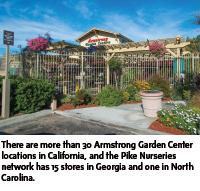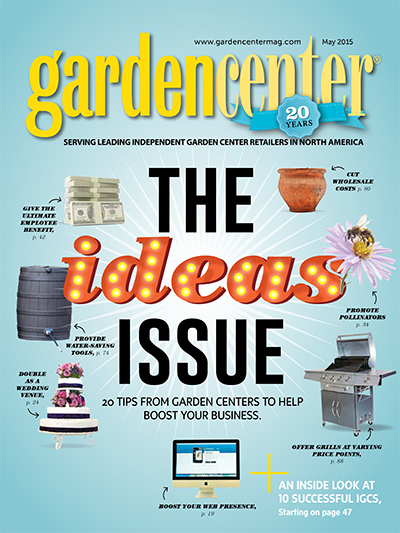 Q: You announced in March that Pike Nurseries is now under an Employee Stock Ownership Plan (ESOP), just like its sister corporation, Armstrong Garden Centers. How long has Armstrong been an ESOP, and why did the company make that decision initially?
Q: You announced in March that Pike Nurseries is now under an Employee Stock Ownership Plan (ESOP), just like its sister corporation, Armstrong Garden Centers. How long has Armstrong been an ESOP, and why did the company make that decision initially?
A: Mr. [Don] Rogers owned the company and built it from four stores to 13, along with Mike Kunce [current CEO and Chairman of the Board for Armstrong Garden Centers and Pike Nurseries.] And in 1987, Mr. Rogers said, ‘I have to sell the company because I need to retire.’ He looked around, like all of us who have something to sell, and the first place he went was Wall Street. He realized pretty quickly that Wall Street doesn’t really understand our industry.
[After looking at other options,] he came to the conclusion that the best stewardship for this company, the people who should own it are the people who actually live it and learn it. That’s when he established an ESOP — a qualified plan for retirement. The federal government was involved, and structured the ESOP in 1987. The 160 employees at the time became owners.
Q: How exactly does it work?
A: Armstrong Garden Center at the time took a loan from the bank, and the bank paid off Mr. Rogers. He sold his interest to Armstrong, and then Armstrong paid back the debt on behalf of all the associates for that ownership. And that’s kind of the whole concept behind the ESOP. The company that’s an ESOP tends to continue to buy itself over and over again. The vesting period is seven years, so the employees wait seven years as the debt is being paid back for them. So when they start to retire, the proceeds from the company go back to repurchase their shares at 20 percent over five years. You constantly have new people coming into the plan as we hire new people, and the people who are retiring, as they go out of the plan, the company buys their shares back and recirculates them to the new employees coming in.
Q: Do employees have to buy into this plan?
A: It doesn’t cost them any money, but the currency that we use is loyalty. So it’s time. The longer that you’re here, the more money you’ll get. Mr. Rogers was an extremely loyal individual, but he demanded that loyalty back. So when he structured this he said any associate that stays and gives their career and their time to this company, they will benefit the most. It’s not free, it’s just that loyalty is the currency.
Q: Do employees assume any risk should the company get into financial trouble?
A: No. It’s in a trust, and it is a qualified retirement plan, so it takes those liability sides out. They only get the benefit side of their shares when the company buys it back, but they don’t take any liability of ownership of the company. Your share value will go up and down, but you don’t take any liability beyond the loss of your value.
Q: Armstrong bought Pike in 2008. Why did you decide to move Pike employees into the plan now?
A: Armstrong Garden Centers bought Pike Nurseries as a bankruptcy, and in that, we brought some investors on with us. That merger does cause some confusion because everyone says, ‘I thought Armstrong Garden Centers already owned Pike because that happened in 2008.’ We did own it, but what happened is that it was an asset of Armstrong Garden Centers, and we bought out those investors. You can have a company that is an ESOP that holds other assets outside of the ESOP, which is what Pike was for the past six years. In 2008, we bought Pike, and for six years we ran it as an outside investment of Armstrong, and now we’re rolling those associates into the ESOP.
Q: What about the timing? If Pike was in bankruptcy, I assume it was in trouble, so were you waiting to roll the company into the ESOP until the business stabilized again?
A: Absolutely. It’s exactly what we did. When we bought it, like with any company that goes through bankruptcy, there’s some brand damage, and Georgia was also in a drought when we bought it in 2008. So we wanted to make sure it did stabilize, keep an arm’s distance, and our intent was always to roll it into the ESOP. Buying investors out so that we could bring the companies together was the plan. Pike has performed very well, and it’s a very strong company. The brand equity has grown. The reason that we decided to do it was for the same principles that Mr. Rogers had when he set up the Armstrong ESOP. Those associates should be benefitting from the company.
 Q: What are the benefits for the ESOP companies?
Q: What are the benefits for the ESOP companies?
A: The benefit is to live Mr. Rogers’ vision that all the horticulturists and people who work here will have this ownership and retirement. In retail, some employees think it’s just a job. They come in, they punch the clock, they get their wage and they move on. Our turnover is really low as a retailer; the tenure of our associates is in the 15-year range on average, and so they have that sense of ownership. We have shareholder meetings every year, and they have a lot of input into the company. They are thinking about their ESOP with every decision they make, whether it’s customer service or whether it’s buying product. I have 1,200 business partners with me every day running the company, so that is a huge benefit for the company. Way back when, you’d go work for a company and you’d be there for your whole career.
Now it’s not uncommon to look for jobs every 3 to 5 years. But ESOP companies have an ability to make people look at their employment differently.
Q: How many people will you now have in the ESOP since Pike is included?
A: Between Armstrong and Pike, we’re usually at around 1,200 employees. People who are retiring, they’re going through the program even though they’re no longer an employee because they are still an ESOP holder.
Q: Will the Pike and Armstrong brands remain separate?
A: There is brand equity on both coasts. The Armstrong customers in California have been associated with this brand for many years, and Mr. [Pete] Pike started Pike Family Nurseries over 50 years ago, and that brand is phenomenal. We will keep them separate.
Q: How did you get started in this industry?
A: I had to work my way through college. I wanted to work in contract law, and I went to this local nursery many years ago. It paid $3.35 an hour, and I always said no matter where I work, I’m going to add as much value to whoever is employing me, even if it is just a place I’m going to be for four years while I work my way through college. So I started taking horticulture classes and plant identification classes, and I fell in love with the industry.
Send your Profiles suggestions to msimakis@gie.net.

Explore the May 2015 Issue
Check out more from this issue and find you next story to read.
Latest from Garden Center
- Ken and Jean Royer Family Fund through American Floral Endowment provides travel grants for retail florists
- Sun Gro Horticulture launches climate-conscious potting mix Sunshine Black Bear
- Dümmen Orange North America hires regional product manager for perennials
- Justin Wisniewski named general manager of Must Have Perennials
- Weekend Reading 6/14/24
- How to achieve an 'imperfectly perfect' cottage garden
- American Floral Endowment accepting new research proposal applications
- Weekend Reading 6/7/24





